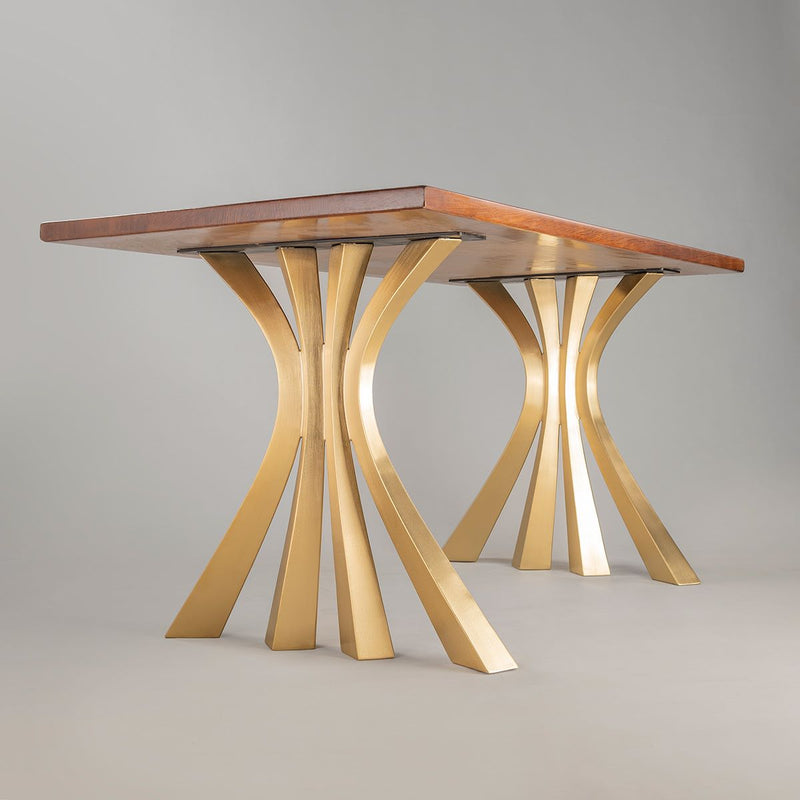Table Legs: How to Select the most effective Designs for Your Area
Choosing the right eating table legs is crucial for both aesthetic and practical consistency in your eating space. Whether your space flaunts a smooth, contemporary vibe or leans towards an extra conventional setting, the style of the legs can considerably affect the overall look. Tapered legs show contemporary elegance, while transformed legs use a nod to timeless charm. Past style, the product-- be it cozy timber or smooth steel-- plays a crucial function in establishing the tone. But just how do you guarantee these aspects complement your existing decoration while supplying the needed security? The solution depends on a well balanced technique.
Analyzing Your Eating Space Design
How do you determine the ideal eating table legs for your area? The response starts with a detailed evaluation of your eating space design. A cohesive layout makes certain that your table legs improve the general aesthetic instead than clash with existing aspects.
Following, take into consideration the existing furniture and style. The products, shades, and textures within the area play an important function. An eating room with smooth, contemporary chairs and metallic accents might benefit from straightforward, structured table legs. On the other hand, a space filled up with vintage pieces and rich materials could call for elaborate, carved legs.
Lighting also affects perception. All-natural light can highlight certain materials and finishes, while synthetic lighting can highlight different elements. Account for the room's scale and proportions. Big, open dining-room can fit much heavier, more considerable legs, whereas smaller spaces need even more fragile, unobtrusive designs. By very carefully evaluating these elements, you can pick eating table legs that sympathetically blend with your eating room's style.
Popular Leg Styles Clarified

One prevalent style is the conical leg, renowned for its sleek, contemporary look. Next off, the turned leg features elaborate spindle-like styles, typically found in conventional and farmhouse settings.
Cabriole legs, with their distinctive curves, are synonymous with French Provincial and Queen Anne furnishings. Their stylish, moving lines bring a feeling of elegance and historic appeal (dining room table legs). For those favoring a durable and simple layout, square legs give durable support and a clean, geometric appearance, suitable for industrial or minimalist areas
Last but not least, barrette legs provide a retro, mid-century modern ambiance. Made from steel, these legs are both light-weight and strong, adding a distinct aesthetic contrast to wooden table tops. Recognizing these designs will certainly direct you in selecting table legs that improve your room's aesthetic and capability.
Material Considerations

Timber is a classic choice, known for its heat and flexibility. It can be found in different varieties such as oak, walnut, and maple, each offering unique grain patterns and colors. Metal legs, frequently made from stainless steel, iron, or aluminum, offer a contemporary and commercial appearance while ensuring durable assistance. They are normally much more immune to use and tear, making them a durable selection.

Other products page like bamboo or rattan offer environment-friendly options, bringing a natural and loosened up ambiance to the eating area. Each product has its benefits and drawbacks, and the very best choice will certainly depend on your particular demands and choices.
Balancing Appearances and Capability
Achieving the perfect why not check here balance in between aesthetic appeals and performance is essential when picking eating table legs. While the aesthetic allure of table legs can dramatically improve the total ambiance of a dining room, their practical aspects can not be forgotten. The style of the legs have to harmonize with the space's décor, yet they ought to likewise provide sufficient assistance and security for the table.
Consider the architectural style of your space. Streamlined, modern interiors might take advantage of minimalist, metal legs that supply a clean and unobtrusive appearance. On the various other hand, conventional setups often complement transformed or sculpted wooden legs that add a touch of elegance and refinement.
Capability encompasses the security and durability of the legs. Trestle legs, known for their effectiveness, can provide solid support for bigger tables, making them perfect for families or constant artists. On the other hand, pedestal legs can use more legroom and flexibility, permitting much better seating arrangements
Additionally, the height and positioning of the legs are important for comfortable dining. Legs put also far inward might hinder seats, while those as well close to the edge can limit movement. Hence, thoughtful factor to consider of both visual and useful components is vital for an optimal dining experience.
Modification and DIY Options
Modification opens up a realm of possibilities for producing eating table legs that are distinctly tailored to your preference and needs. Specific layout components, such as transformed legs, tapered forms, or complex carvings, can be integrated to show your style.
For those inclined in the direction of diy (DO get more IT YOURSELF) projects, producing custom table legs uses both a fulfilling experience and the opportunity to achieve a bespoke aesthetic. Do it yourself fanatics can source basic materials and utilize woodworking or metalworking devices to craft legs that fulfill precise specifications. Furthermore, many online tutorials and workshops give assistance, making the process more obtainable for beginners.
Eventually, whether choosing for professional modification or starting a DIY endeavor, the ability to customize table legs makes certain that the final product integrates with your interior decoration vision, improving both capability and aesthetic appeal.
Conclusion
Selecting the ideal eating table legs requires mindful consideration of the overall design of the eating room, including existing building attributes and furniture. Inevitably, the chosen table legs ought to complement the decoration, supplying both visual allure and sensible support.